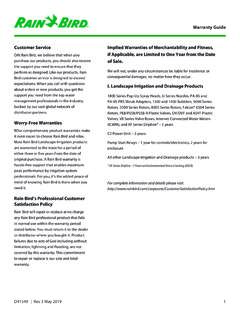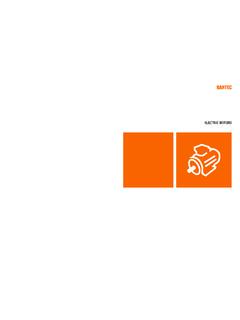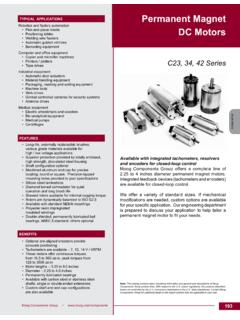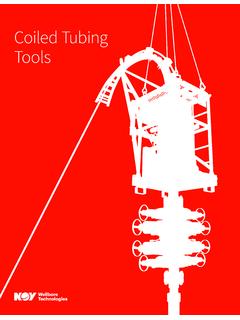Transcription of IEA Wind TCP Task - NREL
1 AieawindMarch 2020 iea wind tcp task 37 Definition of the IEA wind 15-Megawatt Offshore Reference wind TurbineTechnical ReportNREL is a national laboratory of the Department of Energy Office of Energy Efficiency & Renewable Energy Operated by the Alliance for Sustainable Energy, LLC This report is available at no cost from the National Renewable Energy Laboratory ( nrel ) at Contract No. DE-AC36-08GO28308 National Renewable Energy Laboratory 15013 Denver West Parkway Golden, CO 80401 303-275-3000 Technical Report nrel /TP- 5000 -75698 March 2020 Definition of the IEA 15-Megawatt Offshore Reference wind Evan Gaertner1, Jennifer Rinker2, Latha Sethuraman1, Frederik Zahle2, Benjamin Anderson1, Garrett Barter1, Nikhar Abbas1, Fanzhong Meng2, Pietro Bortolotti1, Witold Skrzypinski2, George Scott1, Roland Feil1, Henrik Bredmose2, Katherine Dykes2, Matt Shields1, Christopher Allen3.
2 And Anthony Viselli3 1 National Renewable Energy Laboratory 2 Technical University of Denmark 3 University of Maine Suggested Citation Gaertner, Evan, Jennifer Rinker, Latha Sethuraman, Frederik Zahle, Benjamin Anderson, Garrett Barter, Nikhar Abbas, Fanzhong Meng, Pietro Bortolotti, Witold Skrzypinski, George Scott, Roland Feil, Henrik Bredmose, Katherine Dykes, Matt Shields, Christopher Allen, and Anthony Viselli. 2020. Definition of the IEA 15-Megawatt Offshore Reference wind . Golden, CO: National Renewable Energy Laboratory. nrel /TP- 5000 -75698. NOTICE This work was authored in part by the National Renewable Energy Laboratory, operated by Alliance for Sustainable Energy, LLC, for the Department of Energy (DOE) under Contract No.
3 DE-AC36-08GO28308. Funding provided by Department of Energy Office of Energy Efficiency and Renewable Energy wind and Water Technologies Office. The views expressed herein do not necessarily represent the views of the DOE or the Government. This report is available at no cost from the National Renewable Energy Laboratory ( nrel ) at Department of Energy (DOE) reports produced after 1991 and a growing number of pre-1991 documents are available free via nrel prints on paper that contains recycled content. Acknowledgements Staff from the National Renewable Energy Laboratory ( nrel ) and the Technical University of Denmark (DTU) col- laborated closely, via the International Energy Agency (IEA) wind Task 37 on Systems Engineering in wind Energy, to design the reference turbine described in this report.
4 The authors from the University of Maine (UMaine) lever- aged their expertise and resources to contribute the floating platform semisubmersible design. To better capture the individual contributions, and as a resource for future inquiries, the following table lists the roles and responsibilities for all of the authors involved. Name Institution Contribution Evan Gaertner nrel Primary design engineer who led the blade, tower, and monopile design Jennifer Rinker DTU HAWC2 lead, design load basis, controller tuning Latha Sethuraman nrel Designer of permanent-magnet direct-drive generator, drivetrain, bedplate, nacelle, and other subsystems Frederik Zahle DTU Bend-twist coupling contribution.
5 Rotor and blade design review Benjamin Anderson nrel Created nacelle CAD model and performed drivetrain and bedplate analysis Garrett Barter nrel Project principal investigator Nikhar Abbas nrel Reference OpenSource Controller lead and tuning Fanzhong Meng DTU Controller lead and tuning Pietro Bortolotti nrel Blade design support Witold Skrzypi nski DTU Tool development for blade design George Scott nrel Drivetrain design support Roland Feil nrel Detailed blade structural analysis Henrik Bredmose DTU COREWIND principal investigator Katherine Dykes DTU General support Matt Shields nrel Monopile and transition piece design support, report editing Christopher Allen UMaine Lead semisubmersible design engineer Anthony Viselli UMaine Semisubmersible principal investigator Beyond IEA wind facilitated collaboration between nrel , DTU, and UMaine, the larger networks of individual staff members and the IEA wind Task 37 effort were leveraged to ensure that the design represented a conservative estimate of industry capabilities.
6 These industry contacts gave invaluable information to calibrate our design as- sumptions and input values. Without their input, the 15-MW reference turbine would not be nearly as professional of a design or as useful to the broader community. In no particular order, we extend our thanks to the following companies and individuals: General Electric: Anna Diedrichkeit, Albert Fiass, Vanita Mani, Priyan Subramanian, David Torrey, Yogen Utturkar EDF Renewables: Julien Simon Senvion: Fabian Vorpahl Sintef: Karl Merz Atkins: Ikpoto Udoh nrel : Walt Musial, Jason Jonkman, Nicole Mendoza Sandia National Laboratories: Ernesto Camarena.
7 The work at nrel was sponsored by the Department of Energy Office of Energy Efficiency and Renewable Energy wind Energy Technologies Office under the guidance of program manager, Patrick Gilman. The research at DTU received funding from the European Union s H2020 Program under Grant Agreement no. 815083 - COREWIND. i This report is available at no cost from the National Renewable Energy Laboratory at Nomenclature Acronyms 3D three-dimensional BECAS BEam Cross section Analysis Software DLC design load case DTU Technical University of Denmark HAWTOpt2 Horizontal Axis wind Turbine Optimization 2nd generation HAWC2 Horizontal Axis wind turbine simulation Code 2nd generation IEC International Electrotechnical Commission IEA International Energy Agency metocean meteorological ocean nrel National Renewable Energy Laboratory NdFeB neodymium PSD power spectral density
8 PI proportional integral ROSCO Reference OpenSource Controller RMS root mean squared SRB spherical roller bearing SST shear stress transport TDO tapered double outer TSR tip-speed ratio UMaine University of Maine WindPACT wind Partnership for Advanced Component Technology WISDEM wind -Plant Integrated System Design Engineering Model WP work package Units A ampere h hour Hz hertz kg kilogram m meter min minute N (kgm/s2) Newton rad radian rpm revolutions per minute P period Pa (N/m2) pascal s second t metric tonne T tesla V volt W watt Prefixes m milli k kilo M mega G giga ii This report is available at no cost from the National Renewable Energy Laboratory at Executive Summary Overview and Motivation Reference wind turbines serve multiple roles within the wind community and have therefore grown in importance in recent years.
9 First, they serve as open benchmarks that are defined with publicly available design parameters to be used as baselines for studies that explore new technologies or design methodologies. Second, as an open design, reference wind turbines enable collaboration between industry and external researchers. Finally, reference wind turbines offer an entry point and educational platform for newcomers to wind energy to understand fundamental design elements and system trade-offs. For fixed-bottom offshore wind energy, the average turbine size for European deployment in 2018 was MW [1], and GE will launch its 12-MW Haliade-X offshore turbine to the market in 2021 with a rotor diameter of 218 m and direct-drive configuration.
10 To be relevant now and in the coming years, a new reference wind turbine should leap ahead of the current generation of industry wind turbines, but cannot leap so far that aggressive technology innovations are required. Therefore, a reference wind turbine above 10 MW [2], yet below 20 MW [3], is needed, that continues on the same growth trend as the GE Haliade-X using a similar drivetrain configuration and specific power. This report describes a 15-megawatt (MW) offshore wind turbine with a fixed-bottom monopile support structure. This reference wind turbine is a Class IB direct-drive machine, with a rotor diameter of 240 meters (m) and a hub height of 150 m.

















